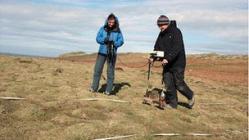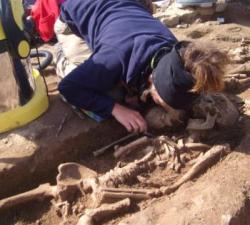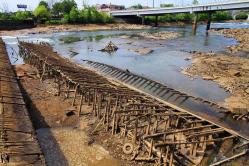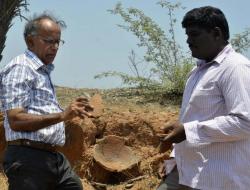INSTITUT SUPERIEUR D'ANTHROPOLOGIE
INSTITUTE OF ANTHROPOLOGY
ONLINE COURSES / COURS A DISTANCE
INSCRIPTION 2012 / Session III : Juillet 2012
REGISTRATION 2012 / Term III : July 2012
FRANCE -  Aiguèze - Les ruines du site dit de La Maladrerie des Templiers, datées des XI-XIIe siècles, se cachent au cœur d'un méandre prononcé des gorges de l'Ardèche, en rive droite, dans le département du Gard. Elles sont situées sur le territoire d'Aiguèze, mais c'est la commune du Garn qui en est propriétaire. À ce jour, on ne connaît rien de son histoire, hormis des interprétations le plus souvent fantaisistes. Une opération archéologique ambitieuse s'avère indispensable pour tenter de disposer d'une base de connaissances fiables. Ce travail est conduit durant tout le mois d'avril sous la houlette du jeune archéologue Nicolas Clément. Le chantier, sous surveillance, est interdit au public
Aiguèze - Les ruines du site dit de La Maladrerie des Templiers, datées des XI-XIIe siècles, se cachent au cœur d'un méandre prononcé des gorges de l'Ardèche, en rive droite, dans le département du Gard. Elles sont situées sur le territoire d'Aiguèze, mais c'est la commune du Garn qui en est propriétaire. À ce jour, on ne connaît rien de son histoire, hormis des interprétations le plus souvent fantaisistes. Une opération archéologique ambitieuse s'avère indispensable pour tenter de disposer d'une base de connaissances fiables. Ce travail est conduit durant tout le mois d'avril sous la houlette du jeune archéologue Nicolas Clément. Le chantier, sous surveillance, est interdit au public
http://www.midilibre.fr/2012/04/06/un-chantier-archeologique-est-lance-a-la-maladrerie-des-templiers,482326.php
ROYAUME UNI –  Skomer Island - A team of archaeologists have found "hidden" remains of prehistoric buildings and fields on Skomer Island, off the Pembrokeshire coast. Using new technology, they "X-rayed" fields and found buried ditches and structures not visible on the ground. Dr Toby Driver from the Royal Commission on the Ancient and Historical Monuments of Wales said they may date back 5,000 years. Skomer Island is a national nature reserve and famed for its bird life and puffins. It also has remains of prehistoric houses and much of the island has been designated an Ancient Monument. But nobody had carried out any archaeological studies of the island since the 1980s.
Skomer Island - A team of archaeologists have found "hidden" remains of prehistoric buildings and fields on Skomer Island, off the Pembrokeshire coast. Using new technology, they "X-rayed" fields and found buried ditches and structures not visible on the ground. Dr Toby Driver from the Royal Commission on the Ancient and Historical Monuments of Wales said they may date back 5,000 years. Skomer Island is a national nature reserve and famed for its bird life and puffins. It also has remains of prehistoric houses and much of the island has been designated an Ancient Monument. But nobody had carried out any archaeological studies of the island since the 1980s.
http://www.bbc.co.uk/news/uk-wales-south-west-wales-17644413
FRANCE –  Béragne - Il y a un an presque jour pour jour, nous annoncions la découverte d'un village médiéval sur le site de Béragne, aux portes de Trèbes, lieu du futur parc économique Paul-Sabatier. Voilà trois semaines, une nouvelle équipe a repris ce chantier afin d'assurer la parfaite fouille de ces vestiges. Sept chantiers avaient été entrepris, allant du néolithique (-4000 av JC) jusqu'à ce village médiéval,en passant par l'âge de bronze et une ferme gauloise. Le plus important est sans conteste ce bourg datant du XIIe siècle avec habitations en pierre, silos, une église et de nombreuses tombes. Aux 150 mises au jour l'an dernier, l'équipe d'archéologues en a ajouté autant depuis la réouverture des fouilles. Dans un espace quadrangulaire d'environ un hectare, ces tombes rupestres se sont développées et se sont superposées au fil du temps. Si les premières se trouvent en plein champ, les plus récentes se situent autour de l'église dans un cimetière clos. Dans chacune d'entre elles, des hommes, des femmes, mais aussi quantité d'enfants gisent, dont les squelettes permettent d'établir leur mode de vie et leur environnement. La pathologie osseuse fait ainsi apparaître une nourriture très grasse. Deux squelettes décèlent un acte médical, l'un présentant une trépanation, l'autre une amputation au niveau de l'humérus. Chacun est démonté, os par os, et envoyé en laboratoire afin de révéler l'identité biologique, et pour pratiquer l'examen de lésions pathologiques. Il reste à ce jour 50 ha sur les 100 à explorer.
Béragne - Il y a un an presque jour pour jour, nous annoncions la découverte d'un village médiéval sur le site de Béragne, aux portes de Trèbes, lieu du futur parc économique Paul-Sabatier. Voilà trois semaines, une nouvelle équipe a repris ce chantier afin d'assurer la parfaite fouille de ces vestiges. Sept chantiers avaient été entrepris, allant du néolithique (-4000 av JC) jusqu'à ce village médiéval,en passant par l'âge de bronze et une ferme gauloise. Le plus important est sans conteste ce bourg datant du XIIe siècle avec habitations en pierre, silos, une église et de nombreuses tombes. Aux 150 mises au jour l'an dernier, l'équipe d'archéologues en a ajouté autant depuis la réouverture des fouilles. Dans un espace quadrangulaire d'environ un hectare, ces tombes rupestres se sont développées et se sont superposées au fil du temps. Si les premières se trouvent en plein champ, les plus récentes se situent autour de l'église dans un cimetière clos. Dans chacune d'entre elles, des hommes, des femmes, mais aussi quantité d'enfants gisent, dont les squelettes permettent d'établir leur mode de vie et leur environnement. La pathologie osseuse fait ainsi apparaître une nourriture très grasse. Deux squelettes décèlent un acte médical, l'un présentant une trépanation, l'autre une amputation au niveau de l'humérus. Chacun est démonté, os par os, et envoyé en laboratoire afin de révéler l'identité biologique, et pour pratiquer l'examen de lésions pathologiques. Il reste à ce jour 50 ha sur les 100 à explorer.
http://www.ladepeche.fr/article/2012/04/09/1326765-le-secret-des-tombes-de-beragne.html
USA –  Colombus - Lying just off the Georgia bank, it's a tank for compressed gas, its valve a ball of rust after years of being submerged in the backwater of the Eagle & Phenix dam. Dynamiting the dam drained the pool behind it, and archaeologists with Southern Research of Waverly Hall have been reconnoitering the riverbed to retrace Columbus' early industrial history. They've found the remains of old wood dams, two wooden buckets and a keg, three guns, numerous bottles, part of a trumpet, and a pipe wrench about 18 inches long,bearing an 1882 patent date.
Colombus - Lying just off the Georgia bank, it's a tank for compressed gas, its valve a ball of rust after years of being submerged in the backwater of the Eagle & Phenix dam. Dynamiting the dam drained the pool behind it, and archaeologists with Southern Research of Waverly Hall have been reconnoitering the riverbed to retrace Columbus' early industrial history. They've found the remains of old wood dams, two wooden buckets and a keg, three guns, numerous bottles, part of a trumpet, and a pipe wrench about 18 inches long,bearing an 1882 patent date.
http://www.ledger-enquirer.com/2012/04/07/2004019/drained-riverbed-reveals-relics.html#storylink=cpy
INDE –  Mandapam- A vast urn-burial site has been found at Mandapam village, near Aarpakkam intersection, about 14 km from Kancheepuram. The importance of the site, archaeologists say, is that it belongs to a period earlier than the Megalithic Age or Iron Age in Tamil Nadu. They estimate that the site is datable to 1,800 BCE to 1,500 BCE, that is, 3,800 to 3,500 years before the present. The site, however, has been ravaged by quarrying for blue-metal. Earth-movers have sliced the big urns and smashed into pieces ritual pottery, bowls and terracotta plates inside the urns. Quarrying has reduced the site to small lakes with deposits of blue metal jutting out and broken urns protruding in places. A stone-crushing machine is filling the air with dust. Dr. Elango, who visited the site a few times, said the flat/conical bottomed urns were buried only one or two feet below the soil surface. While some had ritual pottery and terracotta plates inside, others were empty. There were disintegrated human bones in several urns. More importantly, there were no cairn circles on the surface of the graves to mark them. There were no graffiti marks on the urns. The site could be as ancient as the Adichanallur site, another urn-burial site in Tamil Nadu, Dr. Elango suggested. Cairn circles are big stones, i.e., liths, placed in a circle on the surface of the soil and urns are kept below them. The urns are also kept inside cists, which are compartments made of granite slabs. Since big stones/liths mark the urn burials below, they are called Megalithic Age burials. The Iron Age and the Megalithic Age are contemporaneous in south India. Archaeologists say the Iron Age in south India was extant from 1,000 BCE to 300 BCE.
Mandapam- A vast urn-burial site has been found at Mandapam village, near Aarpakkam intersection, about 14 km from Kancheepuram. The importance of the site, archaeologists say, is that it belongs to a period earlier than the Megalithic Age or Iron Age in Tamil Nadu. They estimate that the site is datable to 1,800 BCE to 1,500 BCE, that is, 3,800 to 3,500 years before the present. The site, however, has been ravaged by quarrying for blue-metal. Earth-movers have sliced the big urns and smashed into pieces ritual pottery, bowls and terracotta plates inside the urns. Quarrying has reduced the site to small lakes with deposits of blue metal jutting out and broken urns protruding in places. A stone-crushing machine is filling the air with dust. Dr. Elango, who visited the site a few times, said the flat/conical bottomed urns were buried only one or two feet below the soil surface. While some had ritual pottery and terracotta plates inside, others were empty. There were disintegrated human bones in several urns. More importantly, there were no cairn circles on the surface of the graves to mark them. There were no graffiti marks on the urns. The site could be as ancient as the Adichanallur site, another urn-burial site in Tamil Nadu, Dr. Elango suggested. Cairn circles are big stones, i.e., liths, placed in a circle on the surface of the soil and urns are kept below them. The urns are also kept inside cists, which are compartments made of granite slabs. Since big stones/liths mark the urn burials below, they are called Megalithic Age burials. The Iron Age and the Megalithic Age are contemporaneous in south India. Archaeologists say the Iron Age in south India was extant from 1,000 BCE to 300 BCE.
http://www.thehindu.com/news/states/tamil-nadu/article3294390.ece
USA – Ozette - The Ozette Site, occupied for over 2,000 years, has been called the Pompeii of the West because of the excellent preservation of baskets, mats, boxes, fishing and whaling tools, and the architectural features of six long houses buried under a clay-based landslide that occurred ca. AD 1700. Through a PowerPoint presentation, Mr. Kirkpatrick will discuss aspects of the historic Makah culture and the material culture recovered from the excavations located on Cape Alava, Olympic Peninsula, Washington by archaeologists from Washington State University.
SRI LANKA – Kandy - Questions are been raised as to whether the necessary approvals have been obtained for new constructions taking place at the Temple of the Tooth (Dalada Maligawa) premises which is an archaeological reserve as well as a world heritage site. According to Dalada Maligawa employees these constructions have come up on the foundations of many archaeological ruins. “It is said that the foundations of Mahavasala, muluthengeya (kitchen) etc; were in these places where the construction work had been carried out. They are archaeological ruins and it is strictly prohibited even to dig a small pit in this area. But interestingly construction work has been going on for several months without any hindrance.
http://www.thesundayleader.lk/2012/04/08/a-temple-chief-running-amok/